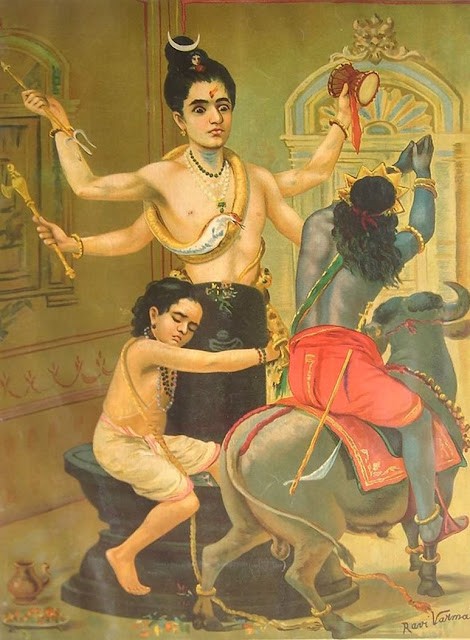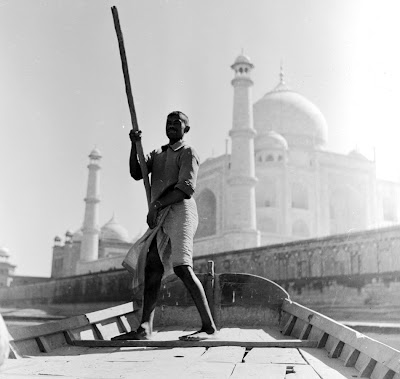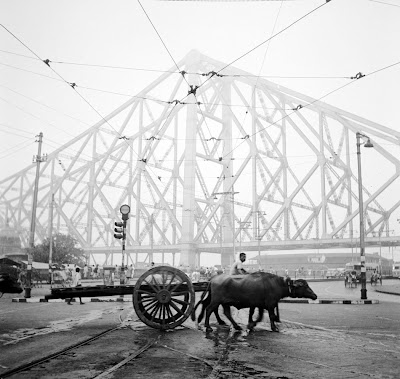I recently got in touch with the renowned Himalayan Academy in Hawaii, USA for permission to reproduce on my website Arunachala Samudra, an excellent article entitled “Hinduism and the Environment” by Matthew McDermott, which had appeared in their online magazine “Hinduism Today”. As well as graciously giving me permission to reproduce the article, they also sent me two reproductions of paintings connected with their Paramaguru Yogaswami’s visit to Arunachala. On receiving the copies of the paintings, I was very interested to learn more about their Paramaguru and his visit to Arunachala. Below is a short biography of this great saint, of who it is said that:
"At 3:30 am on a Wednesday in March 1964, Yogaswami passed away at age 91. The whole nation of Sri Lanka stopped when the radio spread news of his Great Departure (mahasamadhi), and devotees thronged to Jaffna to bid him farewell.”
Yogaswami: The Strange Saint of Sri Lanka
Yogaswami of Nallur, the Sage of Lanka, mystic and spiritual master lived from 1872 to 1964. He was raised in the Hindu faith by his aunt after his mother passed away when he was ten years old. The boy was first educated in a Tamil school and later in a Christian institution where he became proficient in Tamil and English.
Around 1890, Yogaswami found a job as a storekeeper for an irrigation project in Kilinochchi. Here, he lived like a yogi, often meditating all night long. He demanded utter simplicity and purity of himself, as he would later of his devotees.
It is believed that in 1897 a youthful Yogaswami attended a public meeting in Jaffna that was addressed by Swami Vivekananda. When Vivekananda began his talk by saying that "The time is short but the subject is vast", Yogaswami left the meeting immediately after understanding Vivekananda's words to mean that the subject of God is immense whereas even an entire lifetime can be too short for God-realisation. This statement went deep into Yogaswami's psyche. He repeated it like a mantra to himself and spoke it to devotees throughout his life.
In 1905, Yogaswami found his guru Sage Chellappan outside Nallur Temple. As he walked along the road, Chellappaswami shouted loudly: "Hey! Who are you? There is not one wrong thing! It is as it is! Who knows?" Suddenly everything vanished in a sea of light for the young yogi. At a later encounter in a festival crowd, Chellappaswami ordered him, "Go within; meditate, stay here until I return." He came back three days later to find Yogaswami still waiting for his master. Soon afterwards Yogaswami gave up his job and everything else, in order to follow Chellappaswami for the next five years. His life became filled with intense spiritual discipline and severe austerity. Following Yogaswami’s ordination (sannyas diksha), his guru sent him away and never received him again.
As a wandering ascetic Yogaswami walked the length and breadth of Sri Lanka, visiting temples and holy places, and eventually returned to Jaffna. He went on three pilgrimages to India, in 1934, 1940 and 1946, taking a few devotees with him each time. They went on the six-temple Murugan yatra in South India and to the massive, renowned Siva temples of Madurai and Chidambaram. They walked long distances together and met many spiritual luminaries.

On one pilgrimage, Yogaswami visited Sri Ramana Maharshi at Ramanashram in Tiruvannamalai. The two sat in silence for an hour in Sri Ramana’s austere room near the holy mountain. No word was exchanged when they met or parted. After hearing that Yogaswami had visited Sri Ramana, people were eager to find out what had transpired. Swami told them, “We said all there is to say.” Later he added, “We did not go with any desire. Summa we went. We stayed for about an hour. He did not speak at all. He is a great hero (mahaviran).” By “summa,” Swami meant “perfect stillness, communion in silence.”
Yogaswami had a set of favourite aphorisms that he loved to repeat when devotees or strangers called on him. It is generally accepted that these four spiritual truths, which are often quoted nowadays, contain the essence of Yogaswami's teachings:
Oru pollappum illai: There is no evil at all, nothing is wrong. "Good" and "evil" are man-made distinctions.
Muludum unmai: All is Truth (the whole thing is true). The sage who is fully realised sees the entire universe as a manifestation of God.
Nām Ariyom: We do not know. We know nothing. Our minds are limited instruments that can only comprehend things of a mundane nature.
Eppavo Mudintha Karyam: The event was completed long ago. It was all over long ago. Everything has been pre-ordained.

















































